One of the best moments for a produce gardener is plucking a perfectly ripe, home-grown tomato fresh off the vine. Tomatoes are the most consumed fruit in the world due to the enormous versatility of their culinary uses. All around the world, we bake, grill, puree, stew, sauté, smoke, broil, dry, and consume fresh this fantastic food source.
In this guide, we’ll discuss the botanical classification of tomatoes. We will also explore their native range, characteristics, and the various types you can grow. We will conclude with how to grow them from scratch and how to transplant them.
So, without further ado, let’s jump in!
Tomatoes: Botanical Classification, Native Range, and Characteristics
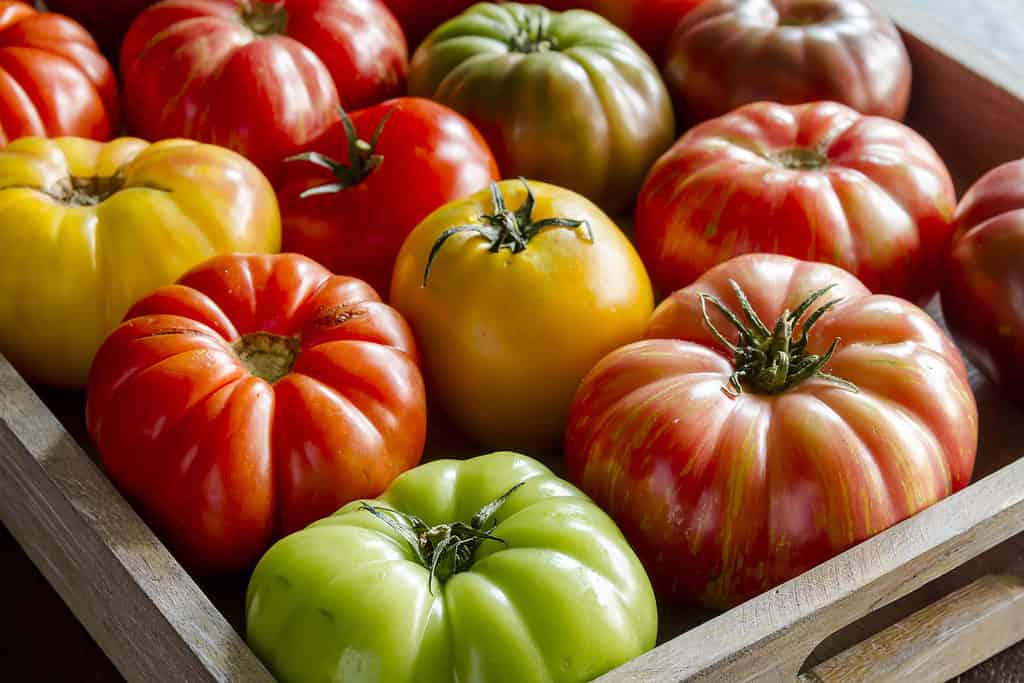
Heirloom tomatoes contain vitamins A and C, beta-carotene, calcium, and fiber.
©Teri Virbickis/Shutterstock.com
A member of the Solanaceae, or nightshade family, the domesticated tomato (Solanum lycopersicum) is the cultivated descendent of the wild tomato, Solanum pimpinellifolium.
The wild tomato, or currant tomato, emerged about 80,000 years ago and is native to Ecuador, Northern Chile, and Peru. This form of tomato still exists today, is about the size of a blueberry, and is packed with flavor.
Researchers believe that through a mix of thousands of years of natural variation and human cultivation, the domesticated tomato emerged. While scientists are not clear on the exact time period or the whole story of its domestication, genetic research confirms that people in this region had been cultivating Solanum pimpinellifolium for thousands of years.
7,000 years ago, this cultivation process created Solanum lycopersicum. At this time, the domesticated tomato was about the size of a cherry tomato. Still, as groups moved throughout Central and North America, domestication continued, and some varieties of tomatoes became larger and less tart.
Today, the domesticated tomato is one of the world’s most valuable food sources. Currently, there are around 15,000 varieties of tomatoes that include naturally occurring and cultivated variations. You can grow a rainbow of tomato colors and produce a symphony of different flavors. Sizes of tomatoes range from the tiny currant tomato to cultivars such as ‘Cuostraleé,’ which can produce fruit weighing up to 4 lbs.
How to Grow Tomatoes
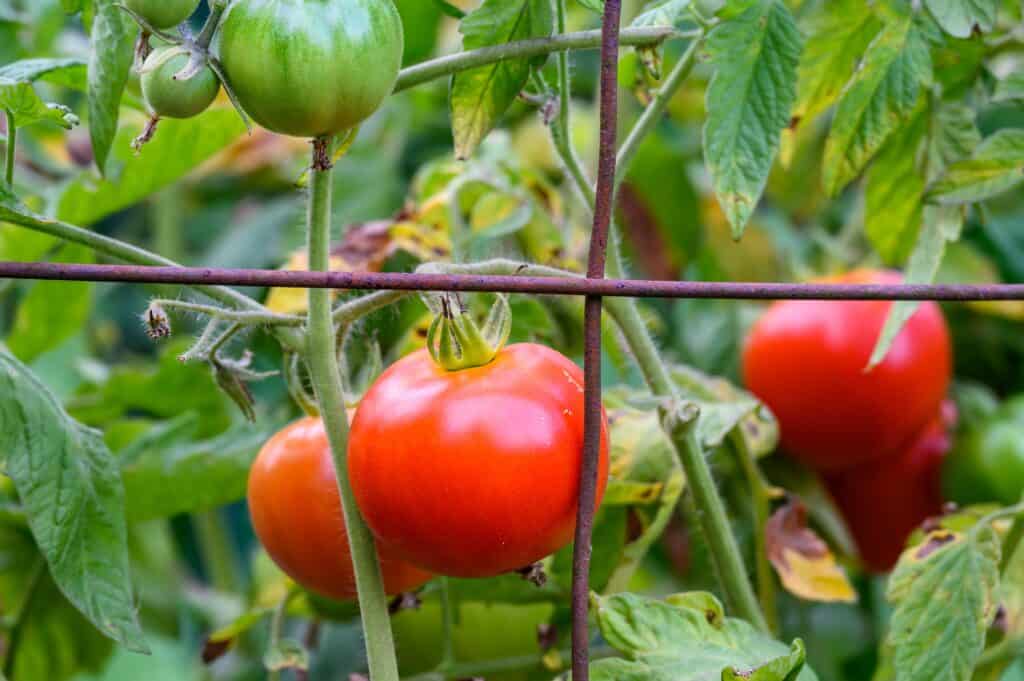
Growing conditions can vary by variety and cultivar, but there are some overlapping general care requirements that all tomatoes need to thrive.
©knelson20/Shutterstock.com
Growing tomatoes is an extremely rewarding endeavor so long as you understand what type of tomato you’re growing needs.
The growing conditions can vary by variety and cultivar, but there are some overlapping general care requirements that all tomatoes need to thrive.
We’ll cover what these conditions are below to help you produce a healthy, bountiful tomato crop.
USDA Hardiness Zones Suitable for Growing Tomatoes
If you live in USDA hardiness zones 5-12, you can grow tomatoes outside from seed and enjoy an abundant harvest. Direct sowing tomato seeds is particularly well-suited to warm climates in zones 8-12. If you can direct sow will depend on your climate zone and what type of tomato you’re growing.
If you live outside of these zones, you can start seeds indoors about 6-8 weeks before the last expected frost date for your area and then transplant them outside 2-4 weeks later.
How to Grow Tomatoes: Ideal Soil Conditions
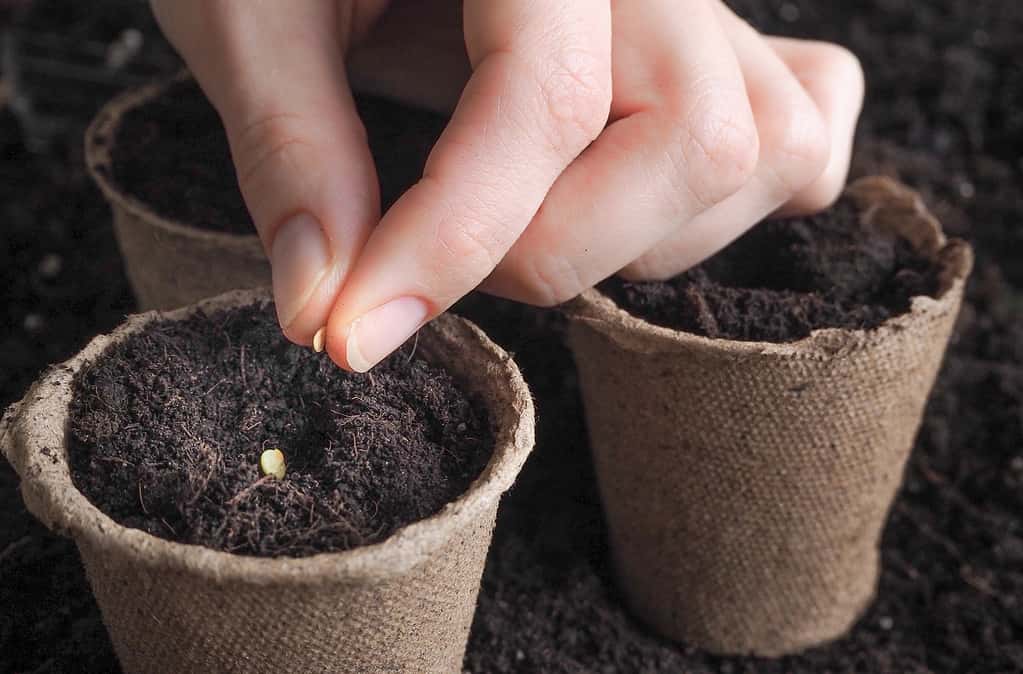
Their ideal soil to grow tomatoes is loamy, well-draining, fertile soil that is slightly acidic (6.2-6.8 pH).
©Stanislav71/Shutterstock.com
Tomatoes aren’t too picky about their soil conditions and can grow in most soil types except heavy clay. Their ideal setup is loamy, well-draining, fertile soil that is slightly acidic (6.2-6.8 pH), but with supportive care, you can grow successful crops in less ideal conditions. Adding peat moss-based compost to sandy soil can help improve the structure and moisture retention.
If your soil is heavy clay, it’s best to grow in raised garden beds, although you can also commit to deep tilling your soil every year and adding amendments to support plant growth. How deep you’ll need to loosen and amend the soil will depend on the variety of tomatoes that you plan to grow, as their root systems can differ.
How to Grow Tomatoes: Ideal Sunlight Conditions
Tomatoes enjoy at least 8 hours per day of full sun. These plants love sunlight, but they can suffer from a combination of full sun and intense heat. If you live in an area that regularly experiences days above 90 degrees Fahrenheit during the growing season, you may want to invest in shade cloths for your tomato plants. You can leave them uncovered during the morning and then cover them in shade cloth for the noon and afternoon.
Companion planting can also help with this the problem of sunlight and heat. Some gardeners grow sunflowers behind their tomatoes to help provide some afternoon shade.
Watering Requirements
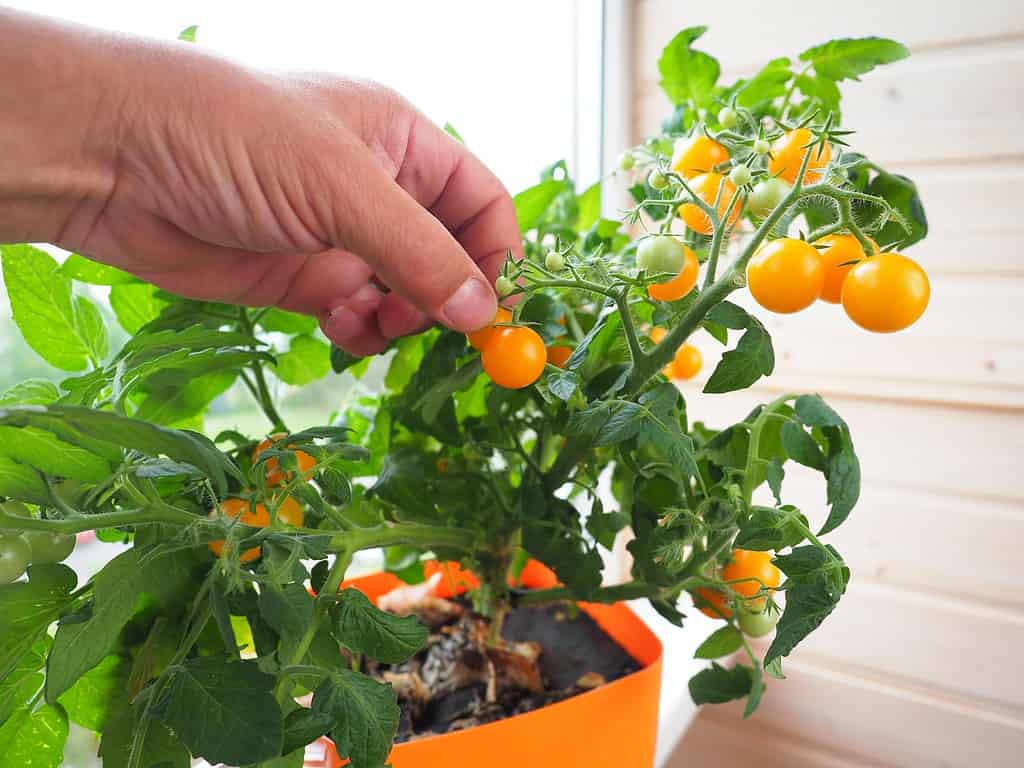
For tomatoes grown in containers, you’ll usually need to water more frequently as the soil in pots can heat up quickly and cause more water evaporation than soil.
©OMfotovideocontent/Shutterstock.com
If you’re growing in garden beds, tomatoes typically need 1-3 inches of water per week, depending on the variety. During the height of the summer, you may need to water once every 2-3 days. For tomatoes grown in containers, you’ll usually need to water more frequently as the soil in pots can heat up quickly and cause more water evaporation than soil. If you’re growing tomatoes in containers, water until it steadily drains out of the bottom of the pot.
Once the fruits are fully mature, you may need to cut back on your watering schedule as the fruits can be prone to splitting from too much moisture. If you see signs of skin splitting, you can cut back watering by about an inch per week.
If you are transplanting tomatoes into your garden, water lightly every day for the first 7-10 days to help your plants become well-established. After that, water the same amount overall, but cut back the frequency to 2-3 times per week.
How to Grow Tomatoes: Fertilizer Requirements
Low-nitrogen fertilizers are the best for tomatoes, as fertilizers high in nitrogen will encourage foliage development at the cost of fruit production. Typically, it’s best to choose an NPK (nitrogen-phosphorus-potassium) mix of 8-32-16 or 6-24-24 to encourage healthy root development and fruit production. Remember, a healthy root system is necessary to support abundant fruiting.
Generally, tomatoes aren’t particularly heavy feeders, and you won’t need to fertilize frequently. Most gardeners apply fertilizers only twice during the plant’s growing phase- once after transplanting and once before fruit production. If you are direct sowing into the garden, wait until the seedlings have 4-5 mature leaves on them before applying fertilizer. Always leave a roughly 4-inch buffer zone around your plant when applying fertilizer to prevent burns.
You can also skip applying fertilizer mixes by incorporating well-developed, high-quality compost into the garden bed before planting. Mulching can help with moisture and nutrient retention.
How to Direct-Sow Tomato Seeds into Your Garden
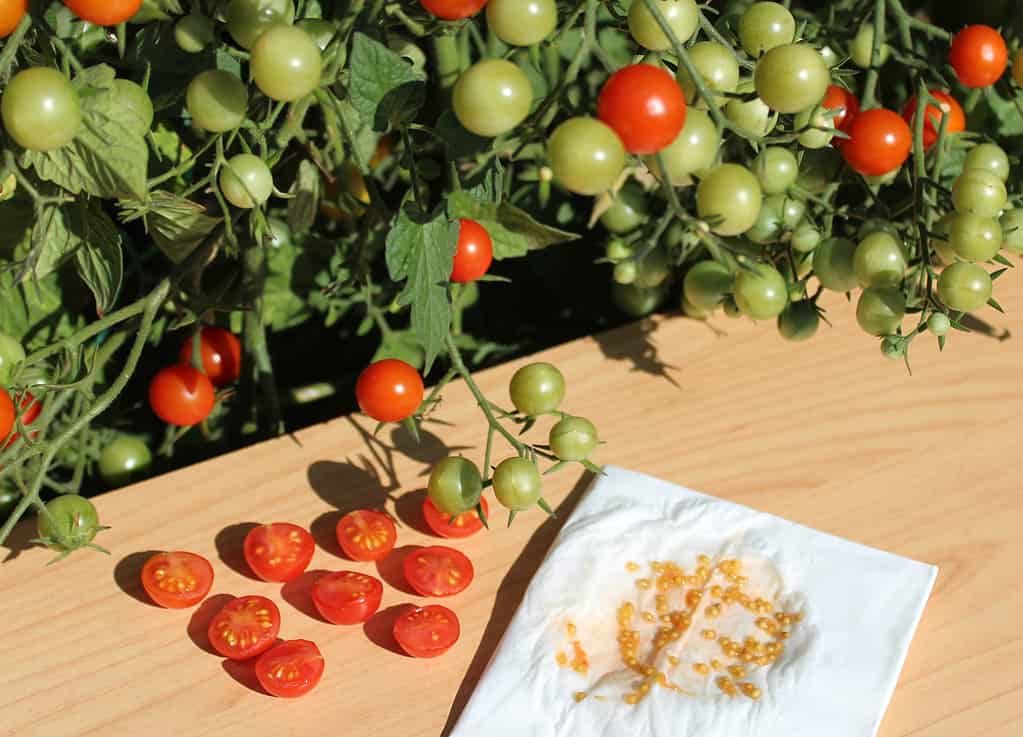
While tomato seeds can germinate at 50 degrees Fahrenheit, it typically takes about 40 days after sowing at this temperature.
©Martina Unbehauen/Shutterstock.com
For tomato seeds, the ideal germination soil temperature range is 65-85 degrees Fahrenheit. In this range, your seeds should germinate within 5-8 days after sowing. While tomato seeds can germinate at 50 degrees Fahrenheit, it typically takes about 40 days after sowing at this temperature.
The best time to direct-sow your tomato seeds is two weeks after the last expected frost date has passed, and temperatures are steadily at least 65 degrees Fahrenheit.
You’ll want to plant the seeds about 1/4″ into moist soil at about 12-18 inches apart, depending on the variety. Consult growing guides for specific spacing requirements of your variety. Rows should be spaced about 3-4 feet apart.
Once the seedlings have reached about 3-4 inches tall, thin the plants to about 1-3 feet apart, again, depending on the variety. Larger cultivars of tomatoes, such as beefsteaks, for example, require spacing at 2-3 feet apart.
How to Transplant Tomatoes
If you live outside of USDA growing zones 8-12, you may decide to start your seeds indoors and then transplant them outside or purchase young tomato plants to transplant. Wait until the soil has reached a minimum temperature of 60 degrees Fahrenheit to transplant your tomatoes into the garden. Ideally, you’ll want to choose an overcast, non-windy day to transplant to decrease the risk of your tomatoes developing transplant shock.
If your seedlings haven’t yet been exposed to outdoor conditions, it’s best to acclimate them to the outside first before transplanting them. This process of gradually hardening off your young plants over a period of one to two weeks prior to transplanting will also decrease the risk of transplant shock.
Once your plants are ready for transplanting and you’ve picked an ideal day, gently remove them from their pots and place them in holes about an inch deeper than their containers. You should space these holes apart according to the specific spacing requirements of your tomato variety. Water every day for the first 7-10 days to help your plants become well-established.
The photo featured at the top of this post is © OMfotovideocontent/Shutterstock.com
Thank you for reading! Have some feedback for us? Contact the AZ Animals editorial team.






